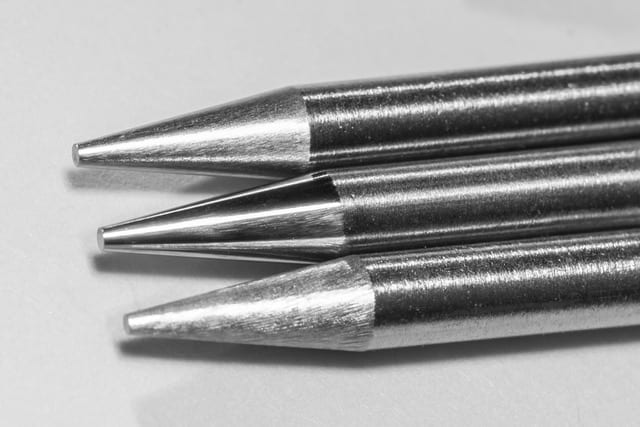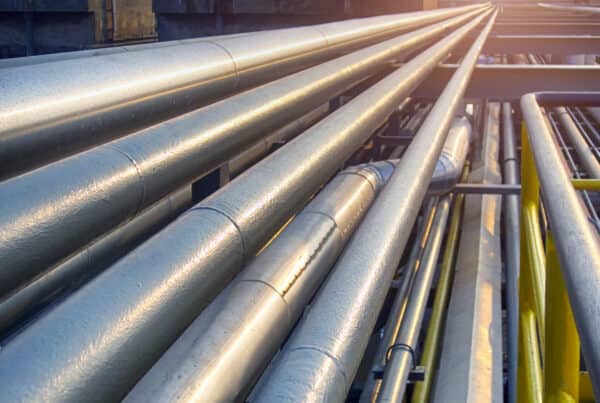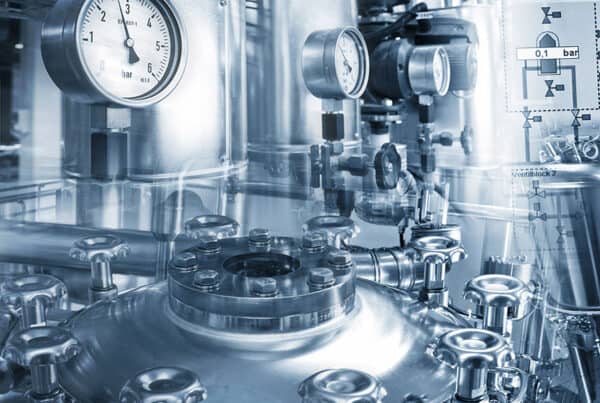
Metals with a thickness of 3 millimeters (⅛ inch) or more are generally too thick to weld with a single pass. Instead, it is customary to bevel both pieces to be joined with an angle between 60 and 75 degrees to reduce the material thickness at the root of the weld. This creates an open angle that is filled in with metal during subsequent welding passes. A common term for this process is v-groove welding. It is a standard method in big bore pipe welding and when joining other thick metal, like plates, during fabrication.
With “pipe” orbital welding, when wire is added to the weld, instead of angled bevels on either side of the joint, a preferred j-shaped groove is machined into the two faces to be welded. The result, when these pieces are joined up, is a groove with a profile resembling the letter U.
Narrow Gap welding is ‘pipe” orbital welding on parts with a wall thickness typically greater than 1/2” (12.5 mm). The “U” joint profile has a reduced bevel angle to keep the joint narrower. Narrow gap (also called narrow groove) welding requires less space to be filled in, meaning the weld can be completed more quickly and with less material consumed. Narrow gap welding is used to complete some of the most critical welds in projects that have some of the most stringent standards.
Preparation for Narrow Gap Welding
While the geometry involved in weld joint preparation for narrow gap welding is similar to that for U-groove welding, narrow groove welding preparation is more specialized.
Creating a j-groove for narrow gap welding involves the following elements:
- Bevel: This is the angle that is machined into the base metal. In the narrow groove welding process, this angle will be steeper than the equivalent angle used in v-groove welding. In v-groove welding, the angle of the bevel is between 30 and 37.5 degrees as measured from the center of the weld; in narrow gap welding, the angle is between 0 and 8 degrees.
- Land Extension: This is the metal that remains at the base of the groove after machining and which will directly abut the neighboring piece to form the base of the joint. The land extension in narrow groove welding differs from v-groove welding in that the weldable—top—surface of the land extension will be curved.
- Land Thickness: In most instances of narrow gap welding, the thickness of the material in the land extension should be no greater than what can be penetrated with a single welding pass, or approximately 1.6 to 3 mm (1/16” to ⅛”). However, there are examples of welding parameters that call for interior diameter welding as well as narrow groove welding.
- Counterbore: This refers to the curve of the j profile. It is effectively a cylinder of removed material. It creates the transition from the surface of the land extension to the more vertically oriented face of the bevel.
- Radius: The radius is the measure of the counterbore from the horizontal center of the weld and a vertical point that is determined by the land thickness called for in the welding specification. The radius connects the upper surface of the land extension and the bevel angle to create the j-profile.
Narrow gap joint preparation involves complex geometry and is best performed using specialized milling or lathing equipment that can maintain precision measurements around the whole circumference of a pipe and across the whole span of a plate. Precision and consistency are especially important in narrow groove welding since this process is frequently used in high-stress applications with stringent requirements.
When Is the Narrow Gap Welding Process Used?
In addition to the advantages of being quicker and requiring less filler material, the narrow gap welding process can join thicker materials than welding using a beveled joint preparation. It can be used to weld metal pieces ranging in thickness from around 12.5 to several hundred mm. If more traditional open-angle welding was performed on a very thick-walled piece, on the other hand, the final gap would be impractically wide. The narrow gap welding process is used for a diverse range of heavy industrial applications; it can be used for welding pipes with thick walls, welding steam generator housings for nuclear power plants, and fabricating steam turbine rotor shafts.
Applications that make use of the narrow gap welding process are generally critical to the final performance of the project. Even in a relatively mundane pipe weld, a flaw can still cause an expensive leak, which may also be a serious safety or environmental hazard. Flaws in a steam generator cut into operating capacity until they are remedied, and repairing them is likely to be time-consuming as well as costly. Flaws in steam turbine shafts, which are the power-generating elements in both conventional and nuclear power plants, could potentially be catastrophic, and revenue losses may go as high as a million dollars for each day that a turbine is non-operational.
Narrow gap welding processes have made it possible to reliably and efficiently fabricate these critical components. In addition to using less material and taking less time, narrow groove welding also makes pipe end preparation and fit-up easier compared to other methods of welding thick-walled materials. However, in spite of these advantages, narrow gap welding presents some inherent challenges due to the geometry of the groove.
The Challenges of the Narrow Gap Welding Process
The geometry and more involved prep work of the narrow gap welding process can lead to issues if they aren’t addressed or if those performing the weld and preparation are inexperienced. The challenges that arise during the narrow gap welding process are:
- Expensive Preparation: Machining in the j-shape of the gap requires specialized hydraulic lathing or milling equipment; grinding is not acceptable. The cost of this machinery and the prep work required is greater than that of standard bevel welds. The use of this machinery also requires more expertise.
- Sidewall Defects: The narrow gap makes it difficult to focus the arc toward the sides of the groove. This means the heat on the sidewalls can fall below that needed to render the metal of the sidewalls molten, causing lack of fusion and leading to additional work or rework to address the flaw.
- Reworking: The narrowness of the groove also makes it more difficult to perform reworking of the weld if a flaw is detected. A weld defect often requires removal of the welded material before it can be welded again, and the narrow groove requires this process to be more precise than in other welding processes.
The drawbacks above can be avoided by using the correct welding process and the correct welding parameters. The critical nature of welds created using the narrow gap welding process means that the use of the highest quality welding processes should be an obvious choice. The best type of welding for use with the narrow gap welding process is likely to be orbital gas tungsten arc welding (GTAW).
Orbital GTAW and Narrow Gap Welding
Orbital welding is a mechanized welding process in which the movements of the electrode are handled either by an automated weld head that closes over the workpiece or one that moves on a track attached to the piece to be welded. These weld heads can operate in areas where access to the joint is limited and can also stay within parameters for an extended period of time without fatigue. This is an advantage in welding any thick-walled material.
Gas tungsten arc welding is widely understood to be the most difficult and slowest welding process, but it is also the one that provides the most consistent and highest quality results. Orbital GTAW welding addresses many of the drawbacks of GTAW by automating the process, saving time and producing higher-quality welds without requiring a welder with extensive experience. Given the critical nature of the joints that the narrow gap welding process is used to produce, the advantages of orbital GTAW are clear. The expense of rework and the serious nature of a weld failure means that orbital GTAW is ultimately the most cost-effective choice for the narrow gap welding process.
Arc Machines, Inc. is the recognized leader in narrow gap orbital welding. For more information about using AMI machines to perform narrow groove welds, contact sales@arcmachines.com. For service contact service@arcmachines.com. Contact us to learn more about custom orbital welding solutions.





